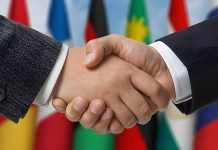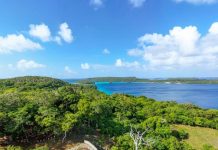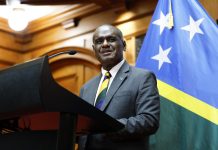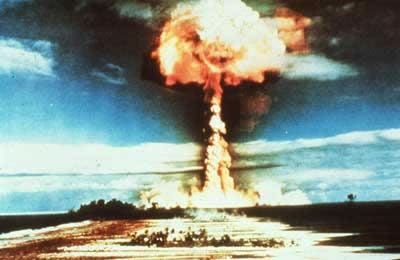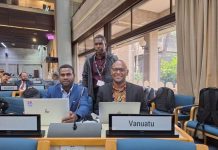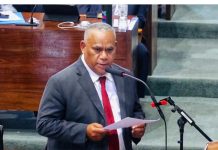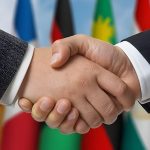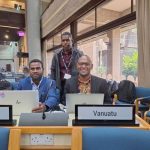By Nic Maclellan in Majuro, Marshall Islands
Gina Langinbelik Anuntak is a student at the College of the Marshall Islands (CMI). She’s President of the CMI Nuclear Club, a student association that unites Marshallese students to understand the legacies of 20th century US nuclear testing.
“We want to learn about the nuclear history that we were never taught when we were kids”, Anuntak said. “The Nuclear Club goes out to visit the survivors in our families, interview them, talk with them and get to know them. It’s always hurtful to hear their sad stories, but they just smile and say ‘It happened.’”
The college students work with local NGOs, church groups and the RMI National Nuclear Commission to raise awareness amongst younger Marshallese. They organise art exhibitions, run a weekly radio show, and contribute to citizen science programs (such as monitoring water supplies).
Showing a picture of her great-grandmother, Anuntak said that many CMI students have family members who witnessed the 67 U.S nuclear tests, conducted on Bikini and Enewetak atolls in the 20th Century.
“The survivors are really fragile, because most of our grandparents went through it,” she said. “They do talk about how scared they were, and some have nightmares about the unexpected event. When we visit people exiled from Bikini, Enewetak, Rongelap or Utirik, we see how much they were affected by it. It’s hard for them to talk about it, but they want to be heard. They want us to learn about our history and continue advocating and educating our generation and younger kids.”
For the descendants of nuclear survivors, the trauma of displacement and illness resonates across the years.
As the first generation of survivors age and die, subsequent generations of Marshallese are grappling with the legacies of the past, and it hurts. With sadness, Anuntak acknowledged that some Marshallese were uncomfortable engage with this history.
“When I was a young girl, my great grandmother would always try to tell us stories about this time, but we were not interested,” she said. “We only learned about American history, but we never learned about our history. My bubu would say ‘they knew what they were doing, they used us.’ But as kids we ignored her, thinking she was talking to herself. If I could turn back time, to have a better understanding while she was still alive, I would sit there and listen to her all day. So now, in my heart, she is the reason we stand up today, for our history.”
For the good of mankind
Soon after the end of the Second World War, the U.S military displaced hundreds of people from the northern atolls in the Marshall Islands, in order to test nuclear weapons and conduct other military activities.
In 1946, U.S Commander Ben Wyatt asked the people of Bikini Atoll if they would leave their islands temporarily, to allow the testing of atomic bombs “for the good of mankind and to end all world wars.” The United States went on to conduct 67 nuclear tests over the next twelve years, before relocating operations to Christmas Island, where they held another 24 atmospheric tests in 1962.
The largest thermonuclear test, codenamed Bravo, was held on 01 March 1954 on Bikini Atoll. The hydrogen bomb test had an explosive yield of nearly 15 megatons, a thousand times more powerful than the US atomic bomb dropped on Hiroshima. It sent plumes of radioactive fallout across most islands of the Micronesian nation, especially impacting the northern atolls of Rongelap, Utirik, Enewetak and Ailininae. All across the Ratak and Ralik archipelagos, atolls received varying amounts of low-level radiation.
In subsequent years, many Marshallese were relocated from their contaminated islands. Some returned to their homes after US assurances that the islands were safe, but many weren’t and they fled again. As a result, there are many elderly survivors living in exile to this day. Their descendants often identify with their lost homeland, even though they’ve never visited and live in the capital Majuro or other islands like Kili and Mejatto.
Some elderly witnesses of the US testing program, uprooted from their islands for decades, want to return home before dying. However parts of the northern atolls remain contaminated to this day, as US and RMI scientists debate whether the decaying radioactive isotopes are still hazardous to human health.
Inter-generation truth-telling
Alson Kelen is a founder of the Waan Aelõñ in Majel programme, working with young people on the construction of Marshallese canoes, and encouraging pride in indigenous culture and knowledge. A master navigator, story teller and former Mayor of Bikini, he serves as a Commissioner of the RMI National Nuclear Commission.
For Kelen, it was encouraging to see the activities of students and young people during the lead up to the Nuclear Victims Remembrance Day on 1 March, as they discussed the history of seventy years ago.
“I went to school in Hawai’i,” he said. “I learned about the bloodiest world war, I learned about American history and world history, but none of this had anything really about nuclear testing in the Marshall Islands. Once in a while, you would run into things that said ‘America dropped the bomb on Hiroshima and Nagasaki to stop the war’. But anything beyond this was not part of American history.”
“I thought that was kind of shocking and brought it up with my classmates and teachers, but they’d look at me and say ‘What are you talking about?’,” he laughed. “In those days, people in Hawai’i didn’t know much about the Marshall Islands or even where the Marshalls is located – even though we’re right next door! So I think that nuclear testing in the Marshalls, and nuclear testing everywhere in the Pacific, should be included in Pacific history courses.”
For Bikinians like Kelen, the long exile from their home island reverberates across the generations.
“My mom just passed away not too long ago, very peacefully,” he told me. “But for a long time, she’d been asking me ‘When are we going back?’. I told her that I didn’t know. But in my heart, I do know. From the articles and studies that I’ve read, it’s hard to see. So I don’t know, but I do – I was lying and not lying at the same time.”
“It saddened me to look at my mother in the face and lie to her,” he said. “I was guilty because I felt I was lying, even though I do not have the full information about whether we’re ever going back. My daughter heard all this and answered her grandmother ‘Bubu, I don’t know if we’re going back.’ But then she turned to me and asked ‘Will we?’ In my mind, I was crying. The truth is, I don’t know. But another truth is, we’re not going back.”
Today, people displaced from their islands by U.S nuclear testing are once again threatened by displacement caused by the adverse effects of climate change. Through his work with the RMI National Nuclear Commission, Kelen wants young people to understand how the nuclear legacies connect to the climate emergency.
He explained that when they moved from Bikini to Ejit island, “my grandfather and his siblings agreed that everyone buried on Ejit would have a concrete frame [for the coffin]. They thought that Ejit was a temporary site, so when we return to Bikini, we can take everyone with us. But today, around that very graveyard, land is eroding so fast, to the point where people want to build a seawall there so our people don’t drift off. The ocean is eating up the land that displaced people are buried in.”
Going home
The trauma of displacement is echoed amongst many survivors who were relocated from other northern atolls, to live on Kili, Ejit, Mejatto or in the national capital Majuro.
Kathy Joel was six years old when the Bravo nuclear test spread radioactive fallout over Rongelap and other atolls. Today, 70 years on, she lives in Majuro but still dreams of return.
Speaking through a translator at an event hosted by RMI President Hilda Heine, Joel recalled the events of 1954: “I remember when I saw planes flying over my island. I was really frightened. My father tried to pick me up, to hold me, but I wouldn’t let him. We were evacuated by the U.S.”
“Until now, I long for my homeland,” she said. “I always think about my homeland and I wish one day – with the help of our President – that I may set foot again on my homeland.”
It’s a heavy burden for President Heine. Since taking office in January, she has visited three of the four main nuclear-affected communities on Kili, Mejatto and Enewetak, with plans to visit people still living on Utirik.
“These visits have taught me that while these nuclear-affected communities continue to survive, thanks to the resilience of the people, they are not necessarily thriving,” Heine said. “There is much that needs to be done to create opportunities for these communities to thrive and to be productive.”
Speaking to Islands Business at her office in Majuro, President Heine reflected on the importance of this year’s Bravo commemoration.
“Every year 1 March is important for us, because we need to not forget what happened,” she said. “We need to look into ourselves and see how we can keep the legacy alive. It was the worst period in the history of our lives and it’s important not to forget that. We cannot allow ourselves to get into that situation ever again. We should continue to talk about it and make sure that it doesn’t happen to anybody else around the world.”
Heine recently appointed David Anitok, Senator for Ailuk Atoll, as a Presidential Envoy for Nuclear Justice and Human Rights: “I’m tasking him to work with the National Nuclear Commission (NNC) to look again at our situation with the nuclear legacy and come up with what we should do going forward.”
The RMI President welcomed the work of the NNC to mobilise young people throughout this month’s 70th anniversary and raise awareness of the nation’s nuclear history: “Every year, 1 March gives us the opportunity for the younger generation to learn what happened and what the nuclear testing program has done to the people of the Marshall Islands, to the land, to people’s psyche and to their livelihoods.”
For NNC Commissioner Alson Kelen, education is the bridge between the ageing cohort of nuclear survivors who witnessed the U.S tests, and younger Marshallese born in the 21st Century.
“When we started the NNC in 2017, we were tasked to do a strategy, which now has five pillars,” he said. “Right now, the one pillar that’s important is education. It can be a bridge from what happened, to what might happen. The first thing we want to do is educate ourselves. We have a curriculum on nuclear issues that is now part of the primary school and secondary schools. We want to fine tune that curriculum, so it tells a story but also opens your eyes to see what you can add to that story.”
Throughout the week before 1 March, NNC staff like Evelyn Ralpho Jeadrick and student leaders helped co-ordinate a series of events for young people. The Nuclear Institute of the College of Marshall Islands (CMI) and the university’s Nuclear Club organised a morning of story-telling, presentations and cultural performances. Students studying overseas zoomed in, including members of the Marshall Islands Students Association at the University of the South Pacific (USP) in Fiji and the Marshallese Educational Initiative (MEI) in Arkansas, USA.
The Marshallese students were joined by a delegation from Japanese universities in Hiroshima and Tokyo. They reflected on the fate of Japanese sailors affected by radioactive fallout from the Bravo test, as dozens of fishing boats near Bikini and Enewetak atolls were showered with radiation from the 15-megaton blast on 1 March 1954. They also discussed the Japanese government’s current program to dump treated nuclear wastewater from the stricken nuclear reactor at Fukushima into the Pacific Ocean.
Regional support
At the ceremony for Nuclear Victims Remembrance Day on 1 March, President Heine sat alongside Pacific Islands Forum Secretary General Henry Puna, Marshallese dignitaries and Lance Posey, Chargé d’affaires in the US Embassy in Marshall Islands.
In his speech, Henry Puna proclaimed: “I stand with you this day to honour and respect the lives of your people – of our people – who bore and continue to bear the permanent inter-generational illnesses caused by nuclear weapons testing in our region.” Puna highlighted the five decades of nuclear testing at ten sites across Oceania between 1946 and 1996: “I stand in solidarity with you, to ensure that we never forget those 50 long years of atrocities perpetrated on our Blue Pacific…It’s sad to see our history is littered with instances of foreign disrespect.”
Mayor of Majuro Ladie Jack pledged ongoing action for people displaced to the capital from other atolls that bore the worst of nuclear fallout in 1954: “In remembrance of our beloved brothers and sisters who are victims and survivors of the dark times from the nuclear testing era – we will not forget and we will not give up our fight. We will remember – always.”
Jess Gasper Jr. is the new Minister for Culture in the Heine administration and has served in the RMI Nitijela (Parliament) as Senator for Bikini. His speech brought tears to many with a passionate call for remembrance and action: “70 years ago today is etched on the minds of our people when our world was turned upside down. 167 people from Bikini were forcefully removed to relocate ‘for the good of mankind’. Out of the 167, only seven are still alive. This is our story – we have not forgotten. We have not forgotten the promise, that if our island home did not turn into glass, we would be able to return. Till this day, the people of Bikini have not been able to go back home. We have not forgotten.”
The climate-nuclear nexus
As part of this mobilisation, the government and people of the Marshall Islands continue to address the nexus between climate change and nuclear contaminants.
A key concern is the potential for radioactive isotopes to leach into the marine environment from the Runit Dome on Enewetak Atoll. After the end of the U.S nuclear testing program in Marshall Islands, this concrete dome was built in the 1970s to cover radioactive-contaminated waste and soil that had been dumped into the deep crater of a previous nuclear test – including contaminated soil that was transported from the Nevada nuclear test site in the United States!
The government highlights the link between nuclear legacies and the climate emergency in a newly published RMI Climate Security Risk Assessment: “Nuclear waste represents an ongoing threat to the Marshallese people and the environment, because of the risk that nuclear waste stored in the Runit Dome cannot be contained.”
President Heine told me that “when you look at sea-level rise and the Runit Dome, there is the possibility that whatever is in there will be seeping into the ocean. It’s very scary for all of us.”
Despite this, youth climate activists across the region share a common slogan: “We’re not drowning, we’re fighting.” As a leader dedicated to youth empowerment and Oceanic identity, NNCs Alson Kelen welcomes their fighting spirit.
“The ocean that provides wealth for the government is crawling closer and closer to our living rooms,” he said. “It’s something that we see every year. But young people here have the strongest pride. They don’t want to move. They want to stay as long as they can, but they also want to go and get educated, to find ways to stay as long as they can. Just like other countries, we want to go out there and get educated, then bring in technologies, bring in capacities that can help us stay on these rocks.”


